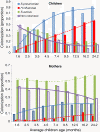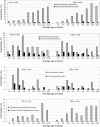Interrelationship of Streptococcus pneumoniae, Haemophilus influenzae and Staphylococcus aureus colonization within and between pneumococcal-vaccine naïve mother-child dyads
- PMID: 24134472
- PMCID: PMC4015913
- DOI: 10.1186/1471-2334-13-483
Interrelationship of Streptococcus pneumoniae, Haemophilus influenzae and Staphylococcus aureus colonization within and between pneumococcal-vaccine naïve mother-child dyads
Abstract
Background: A high prevalence of bacterial nasopharyngeal co-infections has been reported in children, however, such data is limited in adults. We examined the interaction of Haemophilus influenzae, Staphylococcus aureus and Streptococcus pneumoniae pharyngeal colonization in mother-child dyads.
Methods: Pneumococcal-vaccine naïve children and their mothers had pharyngeal swabs undertaken at 1.6, 2.5, 3.5, 4.5, 7.4, 9.5, 12.5, 16.2 and 24.2 months of child's age. Swabs were cultured for S. pneumoniae, H. influenzae and S. aureus using standard microbiologic methods. Multivariate generalized estimating equation-models were used to explore the associations of the three bacteria within and between children and their mothers.
Results: In children, the observed probability of co-colonization was higher than expected. Well-defined associations in colonization between the bacteria were observed in children but not among mothers. In children, a synergistic association was observed between S. pneumoniae and H. influenzae (Adjusted odds ratio (AOR): 1.75, 95% CI: 1.32-2.32) and a negative association between S. pneumoniae and S. aureus (AOR: 0.51, 95% CI: 0.39-0.67) or H. influenzae and S. aureus (AOR: 0.24, 95% CI: 0.16-0.34) colonization. Additionally, all three bacteria had a higher likelihood of concurrent colonization. There was a strong association in colonization by the bacteria in children and their mothers, including increased likelihood of maternal colonization if the child was colonized by S. pneumoniae (AOR: 1.84, 95% CI: 1.28-2.63) and H. influenzae (AOR: 6.34, 95% CI: 2.24-18.0).
Conclusions: The effects of immunization of children with pneumococcal-conjugate-vaccine in settings such as ours needs monitoring with regard to potential changes of pharyngeal bacterial ecology which could occur in vaccinated and -unvaccinated age-groups.
Figures


Similar articles
-
Temporal association of infant immunisation with pneumococcal conjugate vaccine on the ecology of Streptococcus pneumoniae, Haemophilus influenzae and Staphylococcus aureus nasopharyngeal colonisation in a rural South African community.Vaccine. 2014 Sep 22;32(42):5520-30. doi: 10.1016/j.vaccine.2014.06.091. Epub 2014 Aug 4. Vaccine. 2014. PMID: 25101982
-
Longitudinal study on Streptococcus pneumoniae, Haemophilus influenzae and Staphylococcus aureus nasopharyngeal colonization in HIV-infected and -uninfected infants vaccinated with pneumococcal conjugate vaccine.Vaccine. 2015 May 28;33(23):2662-9. doi: 10.1016/j.vaccine.2015.04.024. Epub 2015 Apr 21. Vaccine. 2015. PMID: 25910923 Free PMC article. Clinical Trial.
-
Carriage of Streptococcus pneumoniae, Haemophilus influenzae, Moraxella catarrhalis, and Staphylococcus aureus in Indonesian children: A cross-sectional study.PLoS One. 2018 Apr 12;13(4):e0195098. doi: 10.1371/journal.pone.0195098. eCollection 2018. PLoS One. 2018. PMID: 29649269 Free PMC article.
-
Bacterial respiratory pathogens in children with inherited immune and airway disorders: nasopharyngeal carriage and disease risk.Pediatr Infect Dis J. 2013 Apr;32(4):399-404. doi: 10.1097/INF.0b013e31827db77a. Pediatr Infect Dis J. 2013. PMID: 23552676 Review.
-
Nasopharyngeal microbial interactions in the era of pneumococcal conjugate vaccination.Vaccine. 2013 May 1;31(19):2333-42. doi: 10.1016/j.vaccine.2013.03.024. Epub 2013 Mar 19. Vaccine. 2013. PMID: 23523773 Review.
Cited by
-
Pneumococcal vaccine impacts on the population genomics of non-typeable Haemophilus influenzae.Microb Genom. 2018 Sep;4(9):e000209. doi: 10.1099/mgen.0.000209. Epub 2018 Aug 6. Microb Genom. 2018. PMID: 30080135 Free PMC article.
-
The role of respiratory viruses in the etiology of bacterial pneumonia: An ecological perspective.Evol Med Public Health. 2016 Feb 15;2016(1):95-109. doi: 10.1093/emph/eow007. Evol Med Public Health. 2016. PMID: 26884414 Free PMC article. Review.
-
Experimental Evolution In Vivo To Identify Selective Pressures during Pneumococcal Colonization.mSystems. 2020 May 12;5(3):e00352-20. doi: 10.1128/mSystems.00352-20. mSystems. 2020. PMID: 32398278 Free PMC article.
-
The Etiology of Pneumonia in HIV-1-infected South African Children in the Era of Antiretroviral Treatment: Findings From the Pneumonia Etiology Research for Child Health (PERCH) Study.Pediatr Infect Dis J. 2021 Sep 1;40(9S):S69-S78. doi: 10.1097/INF.0000000000002651. Pediatr Infect Dis J. 2021. PMID: 34448746 Free PMC article.
-
Staphylococcus aureus manganese transport protein C (MntC) is an extracellular matrix- and plasminogen-binding protein.PLoS One. 2014 Nov 19;9(11):e112730. doi: 10.1371/journal.pone.0112730. eCollection 2014. PLoS One. 2014. PMID: 25409527 Free PMC article.
References
-
- Faden H, Duffy L, Wasielewski R, Wolf J, Krystofik D, Tung Y. Relationship between nasopharyngeal colonization and the development of otitis media in children. Pediatr Infect Dis J. 1997;13:132–135. - PubMed
-
- Labout JAM, Duijts L, Arends L, Jaddoe VW, Hofman A, De Groot R. Risk factors for pneumococcal carriage in healthy Dutch infants. The Generation R study. J Pediatr. 2007;13:771–776. - PubMed
-
- Neto AS, Lavado P, Flores P, Dias R, Pessanha MA, Sousa E, Palminha JM, Canica M, Esperanca-Pina J. Risk factors for the nasopharyngeal carriage of respiratory pathogens by Portuguese children: phenotype and antimicrobial susceptibility of Haemophilus influenzae and Streptococcus pneumoniae. Microb Drug Resist. 2003;13:99–108. doi: 10.1089/107662903764736409. - DOI - PubMed
Publication types
MeSH terms
LinkOut - more resources
Full Text Sources
Other Literature Sources
Medical

